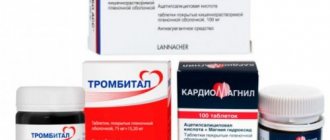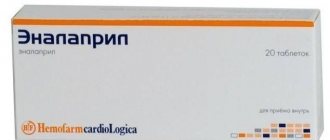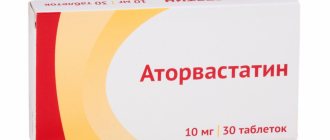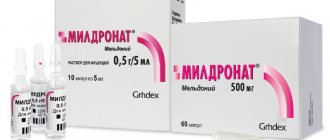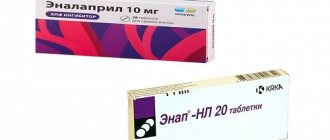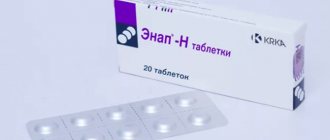Prohibited during pregnancy
Prohibited during breastfeeding
Prohibited for children
Allowed for older people
Has limitations for liver problems
Allowed for kidney problems
Today, the danger of increased concentrations of bad cholesterol in blood plasma has been proven. Hypercholesterolemia can cause serious pathologies, which quite often lead to death. Statins are the most effective medications for lowering cholesterol levels in the blood. This effectiveness is based on their mechanism of action on the body.
There are a large number of statins, but recently drugs of the latest generations are increasingly being prescribed - 3rd generation (Atorvastatin) and 4th generation (Rosuvastatin). These drugs act approximately the same way, but with slight differences, so it is worth finding out which is better - Rosuvastatin or Atorvastatin in each specific case.
Review of Atorvastatin and Rosuvastatin
Atorvastatin is a drug that has a hypocholesterolemic effect.
As it passes through the body, the inhibitor controls the functionality of enzyme molecules that regulate the synthesis of mevalonic acid. Mevalonate is a precursor to sterols, which are found in low-density lipoproteins. 3rd generation statin tablets are used in the treatment of high cholesterol. During the period of atherosclerotic manifestations, the use of the drug shows a positive effect on lipid metabolism, reducing the concentration of lipid fractions of LDL, VLDL and triglycerides, which are the basis for the formation of atherosclerotic tumors. When using the drug, the cholesterol index decreases, regardless of its etiology.
Properties of statins
The drug Rosuvastatin is prescribed when there is an increased concentration of LDL molecules in the blood plasma. The drug belongs to the group of fourth (last) generation statins, where the main active ingredient is rosuvastatin. The latest generation medications containing rosuvastatin are the safest for the body and also have a high therapeutic effect in the treatment of hypercholesterolemia.
The principle of action of the drugs
Atorvastatin is a lipophilic drug that is soluble only in fats, and Rosuvastatin is a hydrophilic drug that is highly soluble in plasma and serum.
The effect of modern drugs is so effective that for many patients one course of drug treatment is enough to reduce total cholesterol, LDL and VLDL fractions, as well as triglycerides.
Mechanism of action of statins
Both drugs are inhibitors of HMG-CoA reductase molecules. Reductase is responsible for the synthesis of mevalonic acid, which is part of sterols and is part of the cholesterol molecule. Cholesterol molecules and triglycerides are components of very low molecular density lipoproteins, which are combined during synthesis in liver cells.
With the help of the drug, the amount of cholesterol produced is reduced, which triggers LDL receptors, which, when activated, begin hunting for low-density lipids, capturing them and transporting them for disposal.
Thanks to this work of receptors, there is a significant decrease in low-density cholesterol and an increase in the content of high-density lipids in the blood, which prevent the development of systemic pathologies.
For comparison, Rosuvastatin does not require transformations in liver cells to begin acting, and it begins to act faster, but this medication does not affect the reduction of triglycerides. Unlike the latest generation of medications, Atorvastatin is converted in the liver, but it is also effective in lowering the TG index and free cholesterol molecules due to its lipophilicity.
Reviews
Oksana, 46 years old, Pyatigorsk: I took Atorvastatin to lower cholesterol. It reduces well, but I experienced side effects myself. After 3 months of regular use, almost all lipid profile indicators, except triglycerides, approached normal. Based on the results of the analysis, the doctor supplemented the treatment with Dibikor, and triglycerides also decreased. I was afraid for my liver, but in vain. Everything is fine there.
Ekaterina, 35 years old, Moscow: I can’t say that Atorvastatin is significantly different in effectiveness from previous drugs. My father was prescribed 60 mg per day; he has high cholesterol. He says that he does not notice any significant changes in his condition after the course of treatment. Cholesterol remains what it was. Apparently this is due to hereditary predisposition.
Kirill, 60 years old, Samara: With a diagnosis of coronary heart disease, the doctor prescribed statins to prevent complications. The choice fell on the drug Rosuvastatin. I don’t feel its influence on myself, but according to tests, cholesterol corresponds to the norm for a healthy person. Before starting to take Rosuvastatin, it was increased several times. I can confidently recommend this drug to others to reduce high cholesterol.
Indications and contraindications
Both drugs have the same direction in the treatment of high cholesterol, and, despite the differences in chemical structure, both are HMG-CoA reductase inhibitors. Statin tablets should be taken for the following lipid imbalances:
- hypercholesterolemia of various etiologies (family hereditary and mixed);
- hypertriglyceridemia;
- dyslipidemia;
- systemic atherosclerosis.
Dyslipidemia
Medications are also prescribed to patients at high risk of developing vascular and cardiac pathologies:
- hypertension;
- angina pectoris;
- cardiac ischemia;
- ischemic and hemorrhagic stroke;
- myocardial infarction.
The cause of hypercholesterolemia is a disorder in lipid metabolism, which often occurs through the fault of the patient himself due to an incorrect lifestyle.
Taking statins will help prevent the development of pathology if taken regularly for preventive purposes in the presence of the following factors:
- food with a high content of animal fat in products;
- alcohol and nicotine addiction;
- nervous tension and frequent stress;
- not an active lifestyle.
The contraindications for these two medications are different (Table 2).
| Rosuvastatin | Atorvastatin |
|
|
Since the emergence of information that the effect of statins in patients with an increased risk of myocardial infarction or stroke increases life expectancy, the question of choosing the most effective and safe drug from this group has become very relevant. The reason for this article was the publication of the results of the largely unique PROVE-IT study, as well as data obtained in the REVERSAL study.
Variety of statins
To date, a fairly large number of different statins have been developed. Lovastatin, simvastatin, pravastatin, fluvastatin, atorvastatin, cerivastatin and rosuvastatin have reached the stage of clinical use. Cerivastatin has been withdrawn due to safety concerns. These drugs inhibit 3-hydroxy-3-methylglutaryl-coenzyme A reductase (HMG-CoA reductase), reducing the synthesis of mevalonate and, accordingly, all substances synthesized with its participation. The action of statins is based on their interaction with the active center of the enzyme. The most obvious and easily recorded result is a decrease in cholesterol (C) synthesis. All statins have a structure reminiscent of HMG-CoA, but more massive and hydrophobic. At the same time, there are significant differences among representatives of this group of drugs.
Statins are divided into 2 classes based on their structure. The first of these includes pravastatin and simvastatin. In addition to a structure similar to HMG-CoA, they contain a decalin ring. Rosuvastatin, atorvastatin, cerivastatin and fluvastatin belong to the second class and contain fluorophenyl and methylethyl groups [1].
Lovastatin, simvastatin and pravastatin are substances originally isolated from Aspergillus terreus, while lovastatin is a natural product (derivative of mevinic acid), while simvastatin and pravastatin are partially modified. Atorvastatin, fluvastatin, cerivastatin and rosuvastatin are completely synthetic drugs.
Lovastatin and simvastatin are prodrugs; the remaining statins are active forms.
The two statins being compared have a number of significant differences in pharmacokinetics (see table). Pravastatin is the most hydrophilic of the statins and significantly more hydrophilic than atorvastatin.
The fact that atorvastatin (like most other statins) is metabolized with the participation of the CYP3A4 isoenzyme indicates that when used together with other drugs metabolized by this cytochrome (cyclosporine, erythromycin, etc.), the risk of side effects may increase . About 47% of the most commonly used drugs are metabolized by CYP3A4.
Pravastatin
To date, one of the most studied statins is pravastatin (a naphthalene-heptanoic acid derivative). In 2003, the results of 28 studies were published, involving 57 thousand patients. In this indicator, pravastatin is superior only to simvastatin, in studies of which more than 78 thousand people took part.
Among studies of the effectiveness of pravastatin conducted in patients with coronary artery disease at high risk of an unfavorable outcome, the most significant is the LIPID (Long-term Intervention with Pravastatin in Ischemic Disease) study, which included 9014 patients aged 31–75 years [2]. At the same time, in 5754 patients the reason for inclusion was a previous myocardial infarction, in 3260 – unstable angina. Pravastatin 40 mg was used in comparison with placebo. The average follow-up period was 6.1 years. The main result of the study was a 24% reduction in the risk of death from coronary artery disease in the treatment group (p
In a study by Ishikawa K et al. [3], published in 2003, found that pravastatin significantly reduced the volume of atherosclerotic plaque measured by three-dimensional intravascular ultrasound after 6 months. The degree of plaque volume reduction was significantly correlated with changes in high-density lipoprotein (HDL) levels and did not correlate with changes in low-density lipoprotein (LDL) or total cholesterol levels.
Atorvastatin
Atorvastatin significantly reduces LDL levels to a greater extent. This is a completely synthetic statin - a derivative of pyrolysis-heptanoic acid. Compared to simvastatin and pravastatin, this drug has been studied somewhat less. The greatest resonance was caused by data showing that the effect of atorvastatin can occur quite quickly. The most revealing results were the results of the MIRACL study.
The MIRACL (Myocardial Ischaemia Reduction with Aggressive Cholesterol Lowering) study examined the effectiveness of atorvastatin compared with placebo in patients who had suffered an acute coronary syndrome (non-Q wave myocardial infarction, large focal myocardial infarction, or an episode of unstable angina). A total of 3086 patients participated in the study, with an average age of 65 ± 12 years [4]. Patients were observed for 16 weeks. As a result, it was found that the incidence of the so-called summary end point (death, non-fatal myocardial infarction, cardiac arrest with resuscitation, readmission due to recurrent ischemia) in the atorvastatin group was lower - 14.8 versus 17.4% in the placebo group, Moreover, the reliability of the difference turned out to be relatively low: p = 0.048. The reduction in the risk of readmission for recurrent ischemia was more significant: p = 0.02. The incidence of stroke in the atorvastine group decreased by 50%. However, the risk of death, nonfatal heart attack, or cardiac arrest did not significantly decrease during the study. The level of LDL cholesterol under the influence of atorvastatin fell statistically significantly by 40% (from 3.3 to 1.9 mmol/l). In addition, while taking atorvastastatin, a significant decrease in pro-inflammatory markers (C-reactive protein, serum amyloid type A) was noted. C-reactive protein during the use of atorvastatin by the 16th week of treatment decreased by 85% and was 34% less than in the placebo group [5]. In the atorvastatin group, a significantly more frequent increase in transaminase levels was noted (2.5 versus 0.6% , R
Thus, by 2000, although atorvastatin demonstrated a more pronounced lipid-lowering effect, pravastatin had more advantages, including potentially fewer interactions with other drugs, greater hydrophilicity and a significant number of controlled studies. There is a need to compare the effects of various statins, which was implemented in two studies, which will be discussed below.
REVERSAL Study
The REVERSAL (Reversal of Atherosclerosis with Aggressive Lipid Lowering) study was conducted to compare the effect of 40 mg pravastatin and 80 mg atorvastatin per day on the dynamics of coronary atherosclerosis [6]. From June 1999 to September 2001, of 2163 patients screened, 654 patients were randomized to receive study drugs. The final analysis included 502 patients (249 in the pravastatin group and 253 in the atorvastatin group) who were able to perform intravascular ultrasound of satisfactory quality at baseline and after 18 months of treatment with study drugs. The main parameter assessed was the dynamics of the volume of coronary atheroma during the study. Baseline LDL level in both groups was 150.2 mg/dL (3.89 mol/L). It decreased to 110 mg/dL (2.85 mmol/L) in the pravastatin group and to 79 mg/dL (2.09 mmol/L) in the atorvastatin group. The significance of differences in lipid dynamics turned out to be highly significant (p
The degree of change in atheroma volume was significantly less during treatment with atorvastatin (p = 0.02). During the use of pravastatin, atherosclerotic lesions progressed (by 2.7%; p = 0.001), while there was no progress in the atorvastatin group over the same period.
The difference between the results of the REVERSAL study and the work of Ishikava K et al. [3] can be explained by at least 3 reasons. First, the work cited in the section on pravastatin was performed on a small number of patients; secondly, the duration of treatment with pravastatin is quite short (only 6 months versus 18 in the REVERSAL study); finally, thirdly, the work was carried out in Japan, and, as is known, the Japanese are significantly more sensitive to statin therapy.
PROVE-IT Study – TIMI-22
The PROV-IT - TIMI-22 study (Pravastatin or Atorvastatin Evaluation and Infection Therapy - Thrombolysis in Myocardial Infarction 22) was conducted to compare 2 statin regimens (and, in fact, compare 2 drugs prescribed in maximum dosages) [7]. Pravastatin at a dose of 40 mg/day was used as a drug that leads to a “standard” reduction in LDL levels below 100 mg/dL (2.59 mmol/L). Atorvastatin was used as a drug to more intensively lower LDL levels to 70 mg/dL (1.81 mmol/L).
From November 2000 to December 2001, the study randomized 4162 patients (men and women over the age of 18 years) hospitalized with acute coronary syndrome (both with and without ST-segment elevation) or who had an episode of unstable high-grade angina. risk within 10 days before inclusion. At the time of randomization, the level of total cholesterol should not exceed 240 mg/dl (6.21 mmol/l), if patients had not previously received statins. If statins were previously prescribed, the TC level should not exceed 200 mg/dL (5.18 mmol/L). Patients who had previously received statins at a dose of 80 mg, as well as those receiving drugs metabolized by CYP3A4, were not included in the study.
For acute coronary syndrome, patients received all necessary treatment, including acetylsalicylic acid, clopidogrel and warfarin. Patients were randomized 1:1 to treatment with atorastatin (80 mg/day) or pravastatin (40 mg/day). In addition, the same study examined the effectiveness of a month-long course of the antibacterial drug gatifloxacin (the results of this part of the protocol have not yet been published). Patients were followed up 30 days after inclusion, then every 4 months until August–September 2003, when the final visit was performed. The follow-up period was 18–36 months (average 24). After 925 endpoints were recorded, the study was stopped.
The endpoints of the study were death from any cause; myocardial infarction, documented unstable angina requiring hospitalization; revascularization (angioplasty or coronary artery bypass grafting) performed later than 30 days after randomization; stroke.
A total of 2063 patients were included in the pravastatin group and 2099 in the atorvastatin group. The groups were completely comparable in all main clinical characteristics, with the exception of the incidence of peripheral atherosclerosis, which was more often observed among patients included in the pravastatin group (p = 0.03).
From the 30th day of the study, a significant difference in LDL levels was noted between the groups (Fig. 2). During the study, the pravastatin group achieved an average LDL level of 95 mg/dL (2.46 mmol/L) and the atorvastatin group achieved an average LDL level of 62 mg/dL (1.60 mmol/L); differences between groups in the degree of LDL reduction were highly significant (p
There was also a significant decrease in the level of C-reactive protein from 12.3 mg/l in both groups to 2.1 mg/l in the pravastatin group and to 1.3 mg/l in the atorvastatin group. The differences in the degree of CRP reduction were highly significant.
The main result of the study was that during therapy with atorvastatin, the incidence of primary endpoints was 16% lower than in the pravastatin group (p = 0.005). At the same time, in the pravastatin group, the incidence of adverse outcomes during 2 years of observation was 26.3%, and in the atorvastatin group – 22.4% (Fig. 3).
Differences between groups began to be noted on day 30 of treatment and persisted throughout the study (Fig. 4).
If we isolate individual end points from the total risk, then during treatment with atorvastatin there was a significantly lower incidence of unstable angina requiring hospitalization (by 29%; p = 0.02), as well as the need for revascularization (by 14%; p = 0 ,04). Risk reductions, although not statistically significant, were observed for the risk of death from any cause (by 28%; p = 0.07) and the composite endpoint of death + myocardial infarction by 18% (p = 0.06). Stroke was rare in both groups and no significant difference was found.
The benefit of atorvastatin was greatest in patients with a baseline LDL level greater than 125 mg/dL (34% risk reduction), while in patients with a baseline LDL level the risk of the primary endpoint was reduced by only 7% (p = 0.02). In addition, the benefit of atorvastatin was more pronounced in patients who had not previously received statins.
The value of the data obtained in the PROVE-IT study lies in the fact that it was conducted by the pravastatin manufacturing company, whose specialists had sufficient reason to expect completely different results. The main hypothesis underlying the protocol was that there would be no difference between the two drugs, despite their different effects on lipids.
So, it should be stated that we have finally moved from comparisons with placebo to direct comparison of the effectiveness and safety of statins. The significance of the results already obtained consists of several points.
The recently published HPS study [8] specifically assessed sensitivity to a standard dose of simvastatin. It turned out that this indicator varies widely, and in 1/3 of patients after 6 weeks of therapy with simvastatin at a dose of 40 mg, LDL levels decreased by less than 38% from the initial level, in another 1/3 - by 38–48%, and for the rest - by more than 48%. At the same time, there were no differences in the degree of influence on the risk of adverse outcomes in these three groups. Thus, the question was raised whether the degree of LDL reduction could predict the effect of a statin on hard endpoints. The PROVE-IT study seems to answer this question in the affirmative. However, it should be remembered that this protocol did not compare two dosages of the same statin, but two different drugs.
An important question is whether these comparisons can be extrapolated to other statins. This primarily concerns rosuvastatin, a drug that leads to an even more pronounced decrease in proatherogenic fractions of blood lipoproteins. In our opinion, there are no grounds for this yet. First of all, it is necessary to ensure that other statins are similarly safe with the same reduction in LDL levels. In addition, direct comparisons are also necessary in order to definitively answer the question of whether the effect depends on the drug or only on the degree of impact on cholesterol metabolism.
Although in the PROVE-IT study the best effect was obtained with the use of a drug that has a more pronounced lipid-lowering effect, it is not possible to exclude the fact that the higher effectiveness of atorvastatin may be due to something else. Indeed, by blocking HMG-CoA reductase for a longer period than most other statins, atorvastatin reduces the synthesis of mevalonate and, accordingly, all products in the synthesis of which this substance takes part, for a longer period. In other words, the other consequences of blockade of mevalonate synthesis when using atorvastatin are more pronounced.
The question about the significance of the lipid-lowering effect in the action of statins could be answered by comparing the effectiveness of atorvastatin and the combination of simvastatin (or another statin) with ezetimibe in a similar protocol. This combination leads to a pronounced decrease in LDL levels, but the mechanism of this decrease is due not only to a decrease in the synthesis of mevalonate, but also to a blockade of the reabsorption of cholesterol in the small intestine. The same effectiveness of these interventions would indicate that the main mechanism of action of statins is the reduction of LDL levels, and everything else is just side effects that have no clinical significance.
A serious question is about the applicability of the data from the studies reviewed in everyday practice. According to their results, intensive statin therapy for acute coronary syndrome in patients admitted to hospital should be started as early as possible. Unfortunately, in our country, these data can be used with very significant restrictions. First, the availability of invasive interventions is very limited, while up to 60% of patients included in PROVE-IT had undergone such an intervention before the start of the study. In our population, many patients simply will not live to see the beneficial effects of statins. Secondly, the use of the 80 mg dosage of atorvastatin is limited by the lack of an appropriate dosage form in Russia.
It is impossible not to dwell on one more point. The data obtained in the PROVE-IT study are relevant to patients at highest risk of developing an unfavorable outcome of coronary artery disease—patients who have just experienced an exacerbation of coronary artery disease. Thus, another step has been taken in choosing the optimal management strategy for patients who have suffered a myocardial infarction or unstable angina.
Instructions for use
Statins should be taken orally with a sufficient amount of water. It is forbidden to chew the tablet because it is coated, which dissolves in the intestines. Before starting a therapeutic course of 3rd and 4th generation statins, the patient must adhere to an anti-cholesterol diet, and the diet must accompany the entire course of medication treatment.
The doctor individually selects the dosage and drug for each patient, based on the results of laboratory tests, as well as the individual tolerance of the body and concomitant chronic diseases. Dose adjustments, as well as replacement of the drug with another medicine, are carried out no earlier than two weeks from the date of administration.
Atorvastatin dosage regimens
The initial dosage for systemic atherosclerosis is Rosuvastatin - 5 mg, Atorvastatin - 10 mg. You need to take the medicine once a day.
Daily dosage for the treatment of hypercholesterolemia of various etiologies:
- for homozygous hypercholesterolemia, the dosage of Rosuvastatin is 20 mg, Atorvastatin is 40-80 mg;
- in patients with heterozygous hypercholesterolemia - 10-20 mg of Atorvastatin, divided into morning and evening doses.
Novostat
The drug is produced by the Russian pharmaceutical company Atoll. Release form: capsules in a dosage of 10 mg. Packaging – 30/60/100 capsules per package. The cost of Novostat is 300–400 rubles. Thanks to the encapsulated form, the medicine is distinguished by high bioavailability. The active ingredient is not destroyed in the stomach, since the capsule does not dissolve in its aggressive environment.
The release of the drug occurs after the capsule passes into the lumen of the small intestine. The active substance penetrates the general bloodstream, then into the liver, where it begins to actively “work”. Novostat can be safely used for gastric ulcers and various forms of gastritis, since the drug does not irritate the damaged mucosa.
Key differences and effectiveness
What is the difference between Rosuvastatin and Atorvastatin? The difference between medications is obvious at the stage of their absorption from the small intestine. Rosuvastatin does not need to be tied to the time of food intake, and Atorvastatin begins to lose its properties if you take the tablet during dinner or immediately after it.
This medication is also affected by taking other medications, because its conversion into an inactive form occurs with the help of liver cell enzymes. The drug is removed from the body along with bile acids.
Additional effects of statins
Rosuvastatin is excreted unchanged in the feces. Do not forget that any long-term treatment requires financial resources. Atorvastatin costs 3 times less than a 4th generation statin, so it is available to different segments of the population. Price for Atorvastatin (10 mg) – 125 rubles, 20 mg – 150 rubles. The cost of Rosuvastatin (10 mg) is 360 rubles, 20 mg – 485 rubles.
Each drug will work differently in each patient's body. The doctor selects medications in accordance with age, pathology, stage of its progression and lipid profile indicators. Atorvastatin or Rosuvastatin reduce bad cholesterol almost equally - within 50-54%.
The effectiveness of Rosuvastatin is slightly higher (within 10%), so these properties can be used when the patient’s cholesterol is reduced above 9-10 mmol/l. Also, this drug is able to reduce total cholesterol in a shorter period of time, which reduces the number of side effects.
Choosing a manufacturer
Which manufacturer is better? Atorvastatin is produced by several Russian pharmaceutical companies, Kanonpharma, Vertex. is Israeli. How do the means differ? The difference between them lies in production technology, degree of purification and the quality of additional components of the drug.
The active ingredient is the same everywhere – atorvastatin. Atorvastatin Teva received good recommendations. The manufacturer pays special attention to the purification of both the main and additional components, which minimizes the risk of developing side effects described in the annotation for the drug.
An analogue is a medicine that contains the active ingredient of the original drug, but differs in the list of additional components. Below are the most well-known Atorvastatin substitutes.
Adverse reactions
The negative effect of a drug on the body is the main factor in drug selection. Statins are among those medications that can cause death if taken incorrectly. To prevent severe side effects, the dosage prescribed by the doctor should not be exceeded and all his recommendations should be strictly followed.
One patient out of 100 experiences the following negative effects:
- insomnia, as well as memory impairment;
- depression;
- sexual problems.
One patient out of 1000 may experience the following side effects of the drug:
anemia;- headache and dizziness with varying intensity;
- paresthesia;
- muscle spasms;
- polyneuropathy
- anorexia;
- pancreatitis;
- disorders in the digestive tract that cause stomach pain and vomiting;
- increase or decrease in blood glucose;
- various types of hepatitis;
- allergic rashes and severe itching of the rash;
- hives;
- alopecia;
- myopathy and myositis;
- asthenia;
- angioedema;
- systemic vasculitis;
- arthritis;
- polymyalgia of rheumatic type;
- thrombocytopenia;
- eosinophilia;
- hematuria and proteinuria;
- severe shortness of breath;
- breast growth in men and impotence.
In extreme cases, rhabdomyolysis, liver and kidney failure may develop.
Interaction with other medications and analogues
Statins may not be compatible with all medications. Sometimes taking two medications together can cause severe side effects:
- When taken together with Cyclosporine, myopathy occurs. Myopathy also occurs when combined with antibacterial agents of the tetracycline, clarithromycin and erythromycin groups.
- A negative reaction of the body can occur when taking statins and Niacin.
If you take Digoxin and statins, the concentration of Digoxin and statins increases. It is not recommended to take statin tablets or grapefruit juice. The juice reduces the medicinal effect of the statin, but increases its negative impact on organs and systems in the body.- Parallel use of statin tablets and antacids, and magnesium, reduces the concentration of statin by 2 times. If you use these drugs at intervals of 2-3 hours, then the negative impact is reduced.
- When combining the use of tablets and protease inhibitors (HIV), then AUC0-24 increases significantly. For people infected with HIV, this technique is contraindicated and can have complex consequences.
Atorvastatin has 4 analogues, and Rosuvastatin has 12. Russian analogues “Atorvastatin-Teva”, “Atorvastatin SZ”, “Atorvastatin Canon” are distinguished by their low price and good quality. The cost of medicines is from 110 to 130 rubles.
The most effective analogues of Rosuvastatin:
- Rosucard is a Czech drug that effectively reduces cholesterol in a short therapeutic course.
Crestor is an American drug that is the original 4th generation statin drug. Crestor - passed all clinical and laboratory studies. The only drawback in it is the price of 850-1010 rubles.- Rozulip is a Hungarian medicine that is often prescribed for atherosclerosis for long-term use.
- The Hungarian drug Mertenil is prescribed to lower bad cholesterol and to prevent cardiac diseases.



